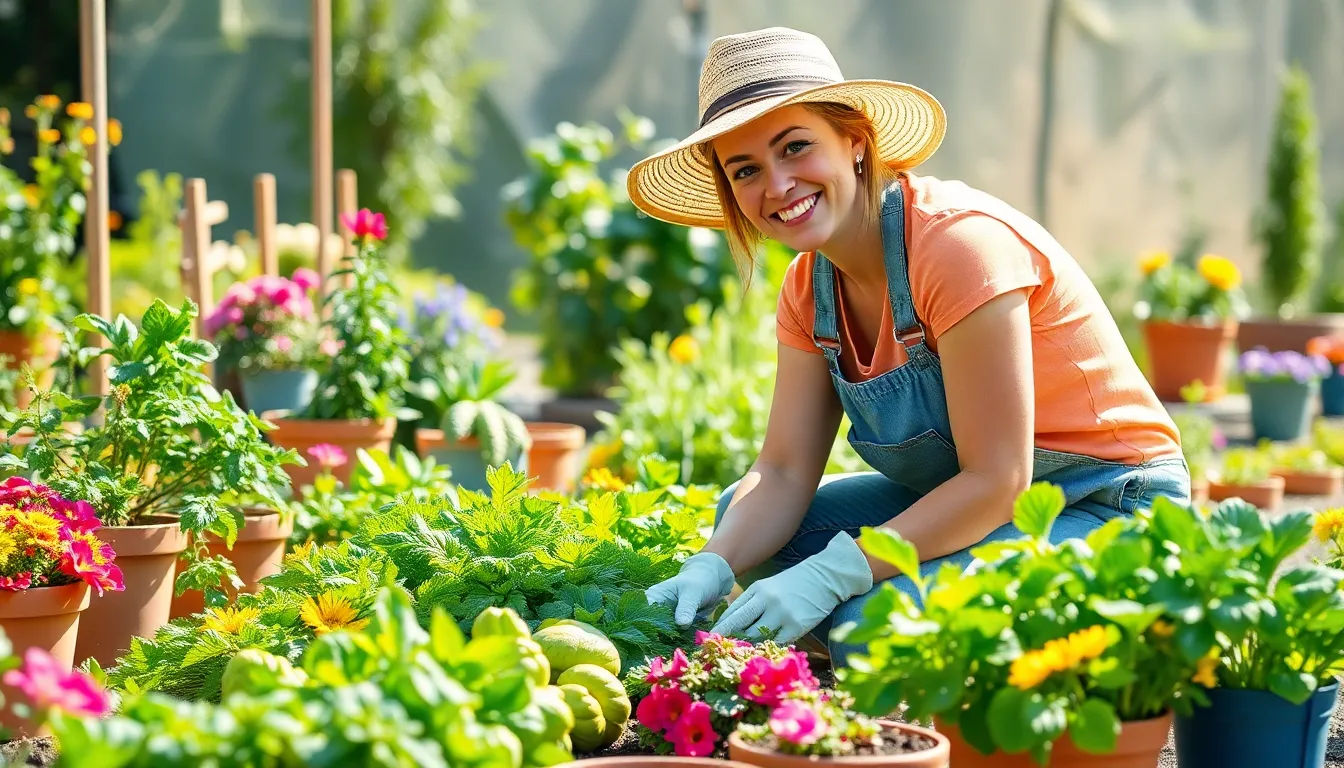Picture this: a fresh basil leaf plucked straight from your own kitchen garden, ready to elevate your pasta dish to gourmet status. Kitchen gardening isn’t just a trend; it’s a delightful journey that transforms ordinary meals into extraordinary experiences. With a sprinkle of patience and a dash of enthusiasm, anyone can cultivate their own little green oasis right at home.
Imagine the joy of harvesting ripe tomatoes or crunchy cucumbers while skipping the grocery store drama. No more wilted greens or questionable produce; just the satisfaction of knowing exactly where your food comes from. Plus, it’s a fantastic way to impress friends at dinner parties—who wouldn’t be wowed by a salad made with homegrown veggies? Dive into the world of kitchen gardening, and discover how it can spice up your culinary adventures and bring a smile to your face.
Kitchen Gardening
Kitchen gardening refers to the practice of growing vegetables, herbs, and fruits close to the kitchen for personal use. This approach allows individuals to cultivate fresh ingredients, enhancing meal preparation and flavor. People enjoy easy access to seasonal produce, providing convenience for cooking without extensive trips to grocery stores.
Gardening can occur in various spaces, including backyards, patios, and even small indoor areas. Urban dwellers benefit from container gardening, utilizing pots or vertical setups to maximize space. Key benefits include ensuring produce freshness, promoting sustainability, and reducing grocery costs.
Common plants in kitchen gardens include basil, tomatoes, peppers, and cucumbers. These selections not only taste better when harvested fresh but also offer higher nutritional value. Careful planning aids in crop rotation, ensuring consistent yields throughout the seasons.
Companion planting, a technique often used in kitchen gardening, involves growing specific plants together to enhance growth and deter pests. This method fosters a natural ecosystem in the garden, contributing to healthy plant development.
Engaging in kitchen gardening encourages a deeper connection with food. Those who grow their own ingredients often appreciate the growing process and the knowledge it brings. Community and social aspects often arise as individuals share their harvests, tips, and experiences with neighbors and friends.
Overall, kitchen gardening transforms simple cooking into a rewarding and memorable experience, ultimately revolutionizing how individuals approach meals.
Benefits Of Kitchen Gardening

Kitchen gardening offers numerous benefits that enhance culinary experiences and improve personal well-being. The practice not only boosts accessibility to fresh produce but also brings joy to the growing process.
Fresh Ingredients
Harvesting ingredients straight from the garden ensures optimal freshness and flavor. Flavorful herbs like basil and cilantro offer aromatic enhancements that elevate dishes. Vegetables such as tomatoes and cucumbers, when picked at peak ripeness, provide superior taste compared to store-bought options. Accessing these fresh ingredients promotes culinary creativity, encouraging experimentation with recipes. Daily cooking becomes a delightful endeavor when individuals can select their produce at a moment’s notice.
Cost Savings
Investing in a kitchen garden yields significant financial savings over time. Eliminating trips to grocery stores reduces overall food expenses, allowing for budget-friendly meal planning. A small investment in seeds, soil, and pots provides a substantial return when producing a variety of vegetables and herbs. By growing food at home, individuals minimize waste generated from pre-packaged produce, further optimally utilizing resources. Families also save on transportation costs associated with grocery shopping.
Health Advantages
Engaging in kitchen gardening contributes to improved health outcomes. Growing one’s own fruits and vegetables encourages a diet rich in nutrients and vitamins. Exposure to sunlight while gardening boosts Vitamin D levels, enhancing mood and well-being. Additionally, consuming fresh, homegrown produce strengthens immune systems and promotes overall health. Gardening also fosters physical activity, contributing to better fitness and well-being. Overall, the practice of kitchen gardening supports a balanced and nutritious lifestyle.
Getting Started With Kitchen Gardening
Starting a kitchen garden involves careful planning and understanding key aspects that contribute to successful growth. Two primary considerations involve choosing the right location and selecting suitable plants.
Choosing The Right Location
Selecting an appropriate spot for a kitchen garden significantly influences plant health. A well-lit area receives at least six hours of direct sunlight daily, ensuring optimal growth of most vegetables and herbs. Protection from strong winds and harsh weather conditions enhances the garden’s resilience. Accessibility to water sources simplifies daily maintenance and irrigation. Additionally, proximity to the kitchen streamlines cooking, enabling quick access to fresh ingredients. Consider these elements when deciding on a location to maximize the benefits of kitchen gardening.
Selecting Suitable Plants
Choosing the right plants plays a critical role in establishing a thriving kitchen garden. Herbs like basil, parsley, and cilantro flourish with minimal space and provide aromatic enhancements to dishes. Vegetables such as tomatoes, peppers, and cucumbers thrive in various garden settings, from pots to raised beds. Seasonal selection ensures plants grow at their best, aligning with local climate conditions. Combining fast-growing plants with longer-maturing varieties keeps the garden productive throughout the year. Including companion plants fosters a harmonious ecosystem while deterring pests. These strategies improve yields and ensure a diverse range of fresh ingredients for everyday meals.
Maintenance Tips For A Successful Garden
Successful kitchen gardening requires diligence and attention. Proper maintenance ensures plants thrive and produce healthy yields.
Watering Guidelines
Watering plays a critical role in plant health. Consistent moisture promotes growth and strengthens root systems. It’s best to water early in the morning or late in the evening, minimizing evaporation. Aim for deep watering sessions, applying one inch of water per week based on rainfall. While the soil should remain moist, overwatering can lead to root rot. Observe plant leaves; wilted or yellowing foliage indicates hydration issues. Utilizing drip irrigation or soaker hoses can deliver water effectively, reducing waste. Periodically check soil moisture by inserting a finger about an inch deep. If it feels dry, it’s time to water.
Pest Management
Managing pests is essential for maintaining a thriving garden. Regular inspections help identify problems before they escalate. Employ natural remedies like neem oil or insecticidal soap for effective treatments. Encourage beneficial insects such as ladybugs or lacewings, which prey on harmful pests. Planting garlic or marigolds can deter unwanted visitors due to their strong scents. Practice crop rotation annually to disrupt pest life cycles, minimizing infestations. Keeping the garden tidy reduces hiding places for pests, enhancing overall garden health. Using physical barriers like row covers can protect young plants from invasion, ensuring robust growth.
Popular Herbs And Vegetables For Kitchen Gardens
Kitchen gardens often thrive with a variety of herbs and vegetables that enhance culinary experiences. Selecting the right plants contributes to both flavor and convenience.
Herbs
Basil stands out as a favorite in kitchen gardens due to its aromatic leaves that elevate numerous dishes. Cilantro adds freshness to salsas and salads, making it a versatile choice. Mint thrives in containers, offering refreshing flavor in beverages and desserts. Thyme, with its earthy aroma, complements meats and vegetables. Chives provide a mild onion flavor, perfect for garnishing soups and salads. Growing these herbs enhances flavor profiles while ensuring quick access to fresh ingredients.
Vegetables
Tomatoes dominate kitchen gardens by offering juicy fruits perfect for sauces and salads. Cucumbers thrive in warm weather, providing hydration and crunch in salads. Peppers bring vibrant colors and varying heat levels, suitable for all types of cuisine. Leafy greens, such as spinach and kale, add nutrient density to meals. Radishes deliver a peppery and crisp bite, making them excellent for salads. Cultivating these vegetables provides a continuous supply of fresh produce, significantly enriching home-cooked meals.
Conclusion
Embracing kitchen gardening opens up a world of culinary possibilities. It transforms the way individuals interact with food while providing fresh ingredients right at their fingertips. The joy of harvesting homegrown herbs and vegetables enhances meals and fosters a deeper appreciation for the cooking process.
With thoughtful planning and consistent care, anyone can cultivate a thriving kitchen garden. Whether it’s a small indoor setup or a spacious backyard plot, the benefits are undeniable. From cost savings to improved health, kitchen gardening enriches lives in numerous ways.
Ultimately, this rewarding practice encourages creativity and sustainability, making everyday cooking a delightful adventure.




